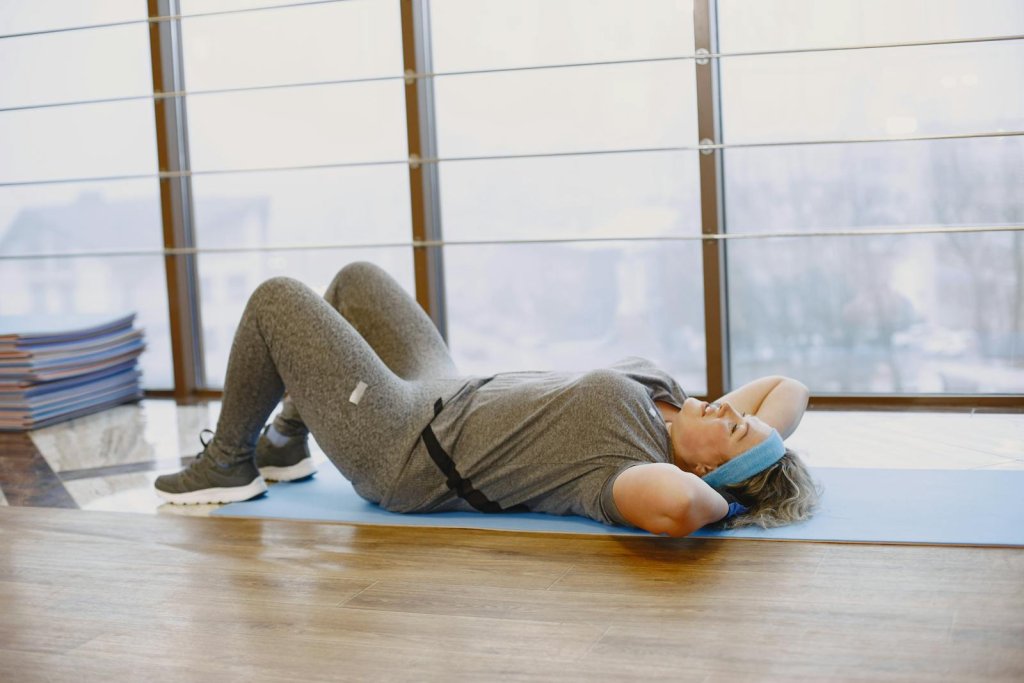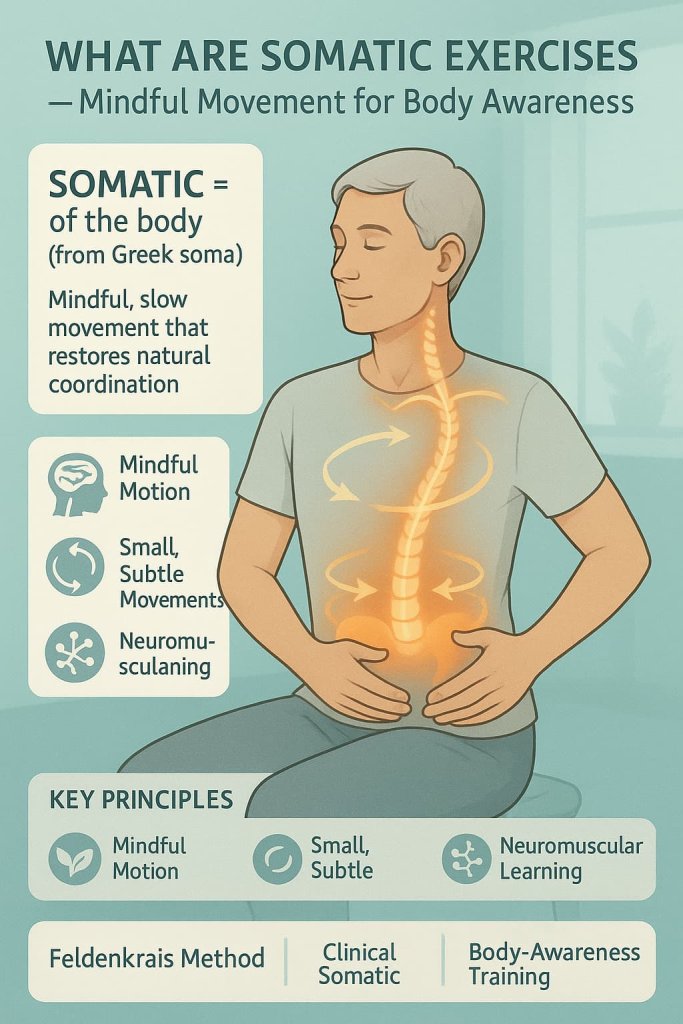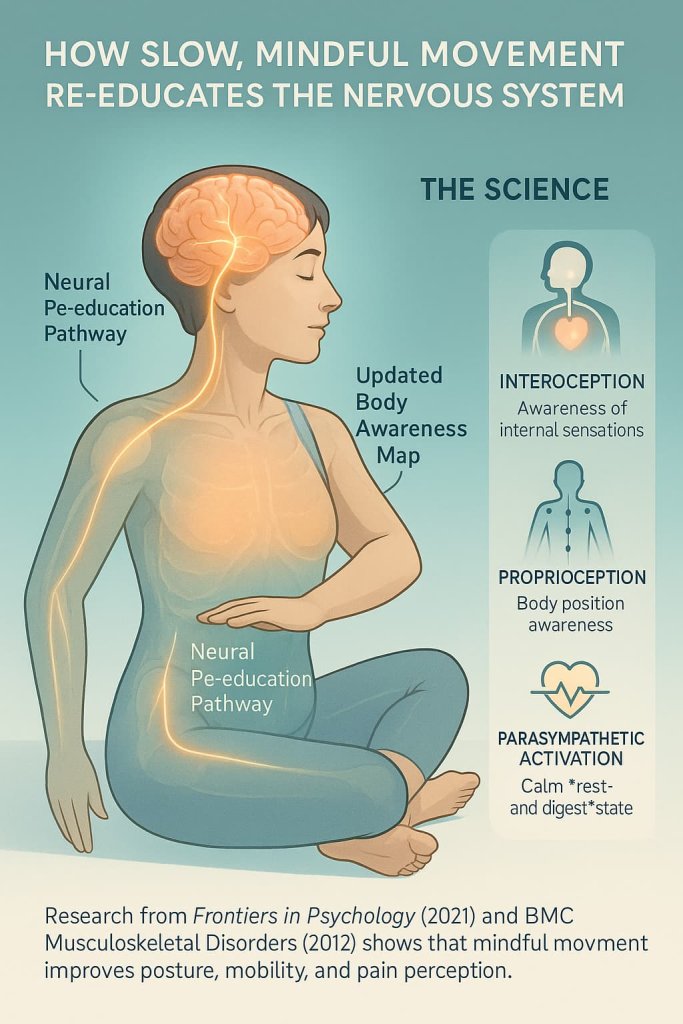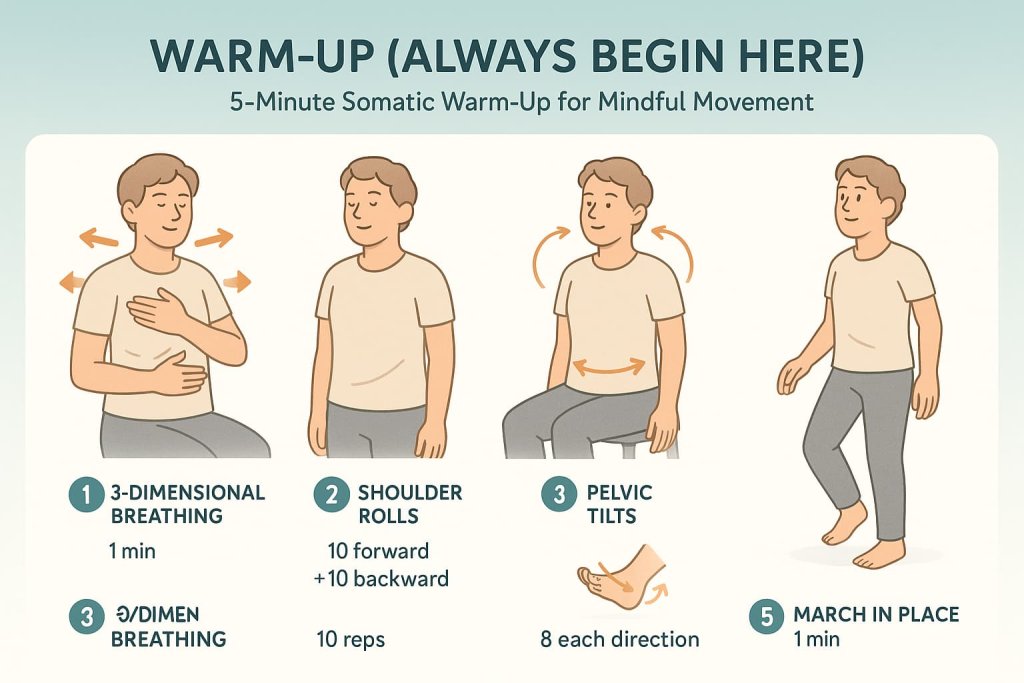Yes — somatic exercises can help rewire your body and mind for relaxation and pain relief.
Unlike traditional workouts that emphasize effort, somatic exercises focus on awareness. By slowing down and tuning into how you move, you can release chronic tension, improve posture, and enhance the way your nervous system responds to stress.

This guide explains what somatic exercises are, why they work, and how to perform them safely. You’ll also find 13 step-by-step movements you can practice anywhere to restore balance, mobility, and calm.
What Are Somatic Exercises?
Somatic exercises are slow, mindful movements that teach your body to move efficiently by increasing awareness of internal sensations.
The word somatic comes from the Greek soma, meaning “the living body in its wholeness.”

Developed by movement pioneers like Thomas Hanna and Moshe Feldenkrais, these practices focus on sensing rather than straining — retraining your muscles and brain to release unnecessary tension.
Key Principles:
- Mindful motion: Move with attention, not momentum.
- Small, subtle movements: Gentle motion improves control and reduces stress on joints.
- Neuromuscular learning: Builds new, efficient movement patterns through awareness.
Example methods include: the Feldenkrais Method, Clinical Somatic Education, and gentle body-awareness training.
Why Somatic Exercises Work
Somatic exercises work by re-educating your nervous system rather than strengthening muscles through intensity.
When you move slowly and consciously, your brain updates its “map” of the body — helping muscles release habitual contractions and restoring smoother, pain-free movement.

The Science:
- Encourages interoception (awareness of internal sensations).
- Enhances proprioception (body position awareness).
- Promotes parasympathetic activation, shifting your body into a calm “rest and digest” state.
Research in journals such as Frontiers in Psychology and BMC Musculoskeletal Disorders suggests that mindful movement practices like somatic exercises improve mobility, posture, and pain perception in adults and seniors.
Warm-Up (Always Begin Here)
Before your somatic session, perform this 5-minute warm-up to wake up your joints and nervous system:

- 3-Dimensional Breathing (1 min): Place a hand on your ribs and breathe fully into the belly, sides, and back.
- Shoulder Rolls (10 forward + 10 backward): Loosen the upper body.
- Pelvic Tilts (10 reps): Gentle front-to-back rocking.
- Ankle Circles (8 each direction): Activate balance sensors.
- March in Place (1 min): Improve circulation and grounding.
The 13 Best Somatic Exercises
These gentle, awareness-based movements help release chronic tension, improve posture, and restore calm to your nervous system. Practice them slowly and mindfully to retrain your body for smoother, pain-free motion.
1) Pelvic Clock
Why it works:
This foundational somatic exercise retrains smooth coordination between your pelvis and spine. It helps relieve stiffness in the lower back, improves pelvic alignment, and restores fluidity to your hip and lumbar movements—often restricted by sitting or stress.
Muscles worked:
Abdominals, gluteals, lumbar stabilizers, hip flexors, pelvic floor.
How to do it:
- Lie on your back with knees bent and feet hip-width apart.
- Imagine your pelvis as a clock face. Slowly tilt it toward 12 o’clock (tailbone down), then 6 o’clock (tailbone up).
- Continue side-to-side (3 o’clock → 9 o’clock).
- Move through each quadrant in a smooth circle, 8–12 seconds per direction. Complete 2–3 full rotations.
Trainer Tip:
Shrink the range if one direction feels “sticky.” The slower you go, the more your nervous system learns control.
2) Rib Glide (Side Bend / Rotate)
Why it works:
Restores flexibility in the thoracic spine and rib cage, encourages full diaphragmatic breathing, and reduces tension caused by shallow chest breathing.
Muscles worked:
Intercostals, obliques, serratus anterior, latissimus dorsi.
How to do it:
- Sit or stand tall with shoulders relaxed.
- Place one hand along the side of your rib cage.
- Inhale deeply to expand ribs under your hand; exhale while gently side-bending or rotating.
- Perform 6–8 breaths each side.
Trainer Tip:
Feel the skin slide and ribs move beneath your hand rather than forcing a deep twist.
3) Head–Neck Tiny Circles
Why it works:
Softens chronic tension at the base of the skull, improves neck mobility, and helps counteract “tech-neck” stiffness.
Muscles worked:
Suboccipitals, sternocleidomastoid, upper trapezius, levator scapulae.
How to do it:
- Sit or stand upright with neutral posture.
- Gently draw tiny, slow circles with your nose, like tracing a coin in the air.
- Make 3–4 circles each direction.
Trainer Tip:
Keep circles small enough that you can sense every muscle fiber releasing—quality over quantity.
4) Shoulder-Scapular Clocks (Wall)
Why it works:
Re-educates the shoulder blades to move smoothly against the rib cage, improving posture and overhead control.
Muscles worked:
Rhomboids, middle / lower trapezius, serratus anterior, deltoids.
How to do it:
- Stand with your back against a wall, elbows bent at 90°.
- Picture each elbow as the hand of a clock. Move elbows slowly around the clock face—12 → 3 → 6 → 9 → 12.
- Perform 3–5 rounds each shoulder.
Trainer Tip:
Focus on the feeling of your shoulder blades gliding—not lifting. If you sense a “catch,” pause and breathe through it.
5) 3-Dimensional Breathing
Why it works:
Reactivates full-body breathing patterns, reduces anxiety, and promotes parasympathetic (rest-and-digest) calm.
Muscles worked:
Diaphragm, intercostals, obliques, deep core stabilizers.
How to do it:
- Sit or lie comfortably.
- Place one hand on your belly, the other on side ribs.
- Inhale through the nose: feel belly rise, ribs expand outward and back.
- Exhale slowly through the mouth. Repeat 8–10 breaths.
Trainer Tip:
Visualize the rib cage expanding like a soft umbrella—front, sides, and back evenly.
6) Ankle Circles with Foot-Ground Awareness
Why it works:
Improves ankle mobility, activates stabilizers for balance, and enhances foot-to-brain connection vital for gait control.
Muscles worked:
Tibialis anterior/posterior, peroneals, gastrocnemius-soleus complex, intrinsic foot muscles.
How to do it:
- Sit upright. Lift one foot slightly off the ground.
- Slowly circle the ankle clockwise 8 times, then counterclockwise 8 times.
- Place foot down; sense weight through heel, arch, and toes.
- Repeat opposite side.
Trainer Tip:
Compare sensations before and after—notice which foot feels heavier or more grounded.
7) Pendulum Hip Swing (Supported)
Why it works:
Releases tight hips and improves balance by restoring natural joint glide.
Muscles worked:
Glute medius/minimus, adductors, hip flexors, hamstrings (dynamic).
How to do it:
- Hold a wall or chair lightly.
- Let one leg swing freely forward/back, then side-to-side.
- Allow momentum to flow; avoid stiffness. Continue 30–40 seconds per leg.
Trainer Tip:
Let gravity lead—your job is to stay relaxed and balanced on the standing leg.
8) Side-Lying Rib Expansion
Why it works:
Loosens tight lateral ribs, improves breathing depth, and relieves side-body compression from sitting.
Muscles worked:
Intercostals, obliques, serratus anterior, latissimus dorsi.
How to do it:
- Lie on your side, knees bent, head supported.
- Place top hand on ribs.
- Inhale deeply into your top ribs; exhale, letting them soften.
- 6–8 breaths each side.
Trainer Tip:
Feel the ribs lift your hand gently on inhale—no force, only expansion.
9) Cat–Cow with Micro-Pause
Why it works:
Improves spinal segment control, coordinates breath with movement, and reduces tension from prolonged sitting.
Muscles worked:
Erector spinae, abdominals, hip flexors, gluteals.
How to do it:
- Start on hands and knees.
- Inhale: drop belly, lift tailbone and head (“Cow”). Pause 2 seconds.
- Exhale: round spine, tuck tail and chin (“Cat”). Pause 2 seconds.
- 6–10 slow cycles.
Trainer Tip:
Initiate from the pelvis—let the motion ripple through your spine like a wave.
10) Seated Chest Opener with Awareness
Why it works:
Counters rounded posture, opens chest and shoulders, and promotes upright alignment.
Muscles worked:
Pectorals, anterior deltoids, rhomboids, trapezius.
How to do it:
- Sit tall. Interlace fingers behind your back.
- Gently extend arms and lift chest slightly as you inhale; exhale and soften.
- Perform 5–6 breaths.
Trainer Tip:
Avoid overarching the lower back—keep ribs stacked over pelvis.
11) Supine Diagonal Leg Slide (“Windshield Wiper”)
Why it works:
Restores hip rotation, trunk coordination, and lower-back suppleness.
Muscles worked:
Obliques, adductors, glute med/min, spinal stabilizers.
How to do it:
- Lie on back, knees bent, arms in a “T.”
- Slide one knee across midline, then return.
- Move slowly, keeping opposite shoulder grounded.
- 8 reps each side.
Trainer Tip:
Let the spine and ribs guide the motion—avoid pulling with your leg.
12) Scapular Slides on Wall
Why it works:
Retrains upward rotation of the scapula—key for overhead mobility and shoulder health.
Muscles worked:
Serratus anterior, lower trapezius, rotator cuff stabilizers.
How to do it:
- Stand facing wall, forearms on surface, elbows at 90°.
- Slide arms up as shoulder blades glide upward, then down slowly.
- 6–10 controlled reps.
Trainer Tip:
Keep gentle pressure through forearms to engage serratus and avoid shrugging.
13) Supported Bridge with Breath
Why it works:
Gently activates the posterior chain while teaching coordinated breathing and pelvic control—ideal for lower-back relief.
Muscles worked:
Gluteals, hamstrings, erector spinae, pelvic floor.
How to do it:
- Lie on back, knees bent, feet hip-width. Optional: place cushion under sacrum.
- Inhale: lift hips 1–2 inches.
- Exhale: lower slowly, sensing the spine articulate to the mat.
- Perform 5–8 reps.
Trainer Tip:
Visualize the back of your pelvis widening as you exhale and lower—this enhances relaxation and symmetry.
How to Include Somatic Exercises in Your Routine
- Frequency: 3–5 sessions weekly
- Session Duration: 10–20 minutes
- When: Morning (to awaken awareness) or evening (to unwind tension)
- Combine With: Strength training, walking, stretching, or yoga as a mindful cooldown.
- Progression: Start small, expand range only when the motion feels effortless.
Example 10-Minute Routine:
- 3D Breathing – 1 min
- Pelvic Clock – 2 min
- Rib Glide – 1 min
- Shoulder-Scapular Clocks – 2 min
- Side-Lying Rib Expansion – 2 min
- Supported Bridge – 2 min
Common Mistakes to Avoid
- Moving too quickly or without awareness
- Holding your breath
- Forcing a range instead of sensing it
- Ignoring pain or discomfort
- Treating somatic work like strength training instead of exploration
Benefits of Somatic Exercises
- Improves posture and spinal alignment
- Reduces chronic muscle tension and stiffness
- Enhances flexibility and joint mobility
- Calms the nervous system and relieves stress
- Boosts coordination and balance
- Increases body awareness and movement confidence
- Complements physical therapy and gentle exercise programs
How to Do Somatic Exercises Safely
Somatic movement is designed to be safe and restorative — but proper setup and pacing are key.
Safety Guidelines:
- Always move slowly; never force range of motion.
- Focus on how each movement feels, not how it looks.
- Stop immediately if you feel sharp or radiating pain.
- Breathe naturally — tension often hides in held breath.
- Consult a healthcare professional if you have recent injuries, neurological conditions, or post-surgical restrictions.
Ideal Frequency:
Practice 3–5 times per week for 10–20 minutes. Consistency builds awareness and rewires patterns over time.
FAQs About Somatic Exercises
Q1: Are somatic exercises safe for seniors?
Yes — they are gentle, low-impact, and easily modified. Always move slowly and use support if needed.
Q2: How soon will I feel results?
Many people notice relaxation or mobility after one session, but consistent practice for 4–8 weeks builds lasting changes.
Q3: Can I use them for stress relief?
Absolutely. Somatic breathing and slow movement stimulate the parasympathetic nervous system, reducing tension and anxiety.
Q4: Do I need equipment?
Just a mat or soft surface. Optional: cushion, wall, or chair for support.
Q5: Can I combine somatic exercises with yoga or physical therapy?
Yes — they complement both by enhancing awareness and coordination.
Conclusion
Somatic exercises are a powerful way to reconnect your body and mind. They teach you to move with awareness, restore natural alignment, and relieve tension without strain.
Start today: choose three exercises, practice for ten minutes, and notice how your body feels before and after. Over time, you’ll move with greater ease, confidence, and calm.
Disclaimer:
This article is for informational purposes only and not medical advice. If you have pain, injury, or medical conditions, consult a qualified healthcare provider before beginning any exercise program.
References
- Hillier & Worley (2015) — Feldenkrais effectiveness systematic review (Evidence-Based Complementary and Alternative Medicine)
https://www.hindawi.com/journals/ecam/2015/752160/ - Hodges & Tucker (2011) — Moving differently in pain: motor adaptation (PAIN)
https://pubmed.ncbi.nlm.nih.gov/21392863/ - McKeon et al. (2015) — The Foot Core System (British Journal of Sports Medicine)
https://bjsm.bmj.com/content/49/5/290
